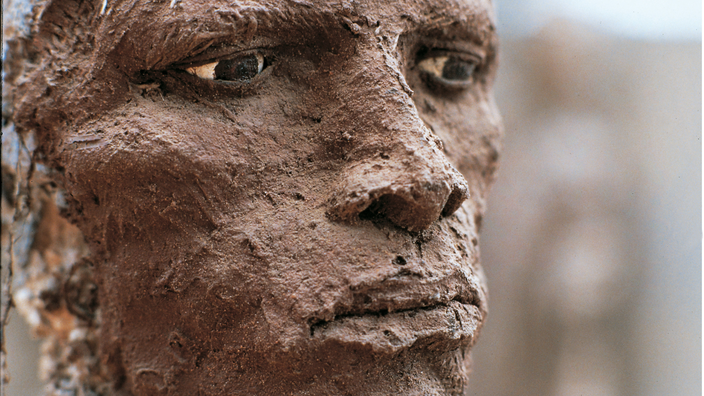Raw silhouettes, frozen, tense, ready to leap, leap, kill or collapse.
The 24 warriors and 11 horses that form the
Little Bighorn
series
by sculptor Ousmane Sow (1935-2016), represent, in several fleeting moments, all the violence of the eponymous battle which took place in Montana on June 25, 1876. Inspired by what he called
"one of India's most brilliant victories"
, the Senegalese artist had taken three years to form, from 1996 to 1999, this epic set of 35 oversized statues.
More than twenty years after their Parisian exhibition on the constrained space of the Pont des Arts, these figures in flesh of the earth take up residence this summer in the fortified city of Mont-Dauphin (Hautes-Alpes).
They will be exhibited there in the restored and refurbished attic of the Rochambeau barracks for the next ten years.
Read also: Paris pays tribute to sculptor Ousmane Sow
Revealed as a sculptor after a first long career as a physiotherapist, Ousmane Sow considered this group of American effigies as his most important work. After having worked until then on African subjects, the dreary plain of Little Bighorn will be his symbolic crossing of the Atlantic, where he represents various figures - historical or anonymous - having participated in the battle of Little Bighorn, various Indian chiefs. to cornered American soldiers led by General Custer.
"I had thought of leaving Africa a little to create another ethnic group which would come a little closer to our customs, and I thought of the American Indians
," the sculptor had confided at the beginning of his work on this statuary group. .
Like most African peoples, they care about their bodies, have a taste for make-up, and revere their sorcerer
”.
Among the most impressive works in the series are Indian horsemen.
Béatrice Soulé / Roger Viollet ADAGP
Scenographed by the director and companion of the artist, Béatrice Soulé, the route takes up the division into two stages that had originally been thought out by Ousmane Sow: the stormy heart of the battle separated from the scenes that precede and follow the shock bodies. The charges, the fiery strides and the retaliations therefore respond to serene statues - the
Sitting Bull in prayer
, a scene from
Clairon
- and episodes of carrion, showing a
Scène de scalp
or
La mort de Custer
. A staging of visceral visions which testifies to a deep plastic and bodily research.
“His works are the culmination of patient work and a long reflection on the human body.
, explains Jacques-André Bertrand in the catalog raisonné to be published with the opening of the exhibition.
A body that he does not hesitate to grind, deform, recreate, to bend it to what he wants to express ”. “It's so wonderful, it's beautiful, it's immense
, also underlined in April, for TV5 Monde, Jean-Louis Gazanion, a friend of Ousmane Sow who participated in the transport of works from Dakar to Mont- Dolphin.
He worked on it relentlessly, non-stop; he fell asleep on it, it's extraordinary.
Caught in a pincer movement by the combined Sioux and Cheyenne forces led by Sitting Bull and Crazy Horse, General Custer's American troops were struck down during an engagement which American history has vividly remembered. One of the last coup d'etat against the United States during the Indian Wars, the battle has been the subject of a profuse scientific, fictional and artistic literary production for more than a century, when Ousmane Sow seizes in turn of the subject. The material he shaped for this illustrious victory immediately aroused unprecedented enthusiasm: in Paris, in 1999, more than 3 million people flocked to admire the sculptures of the man who, in 2013, would be the first black to enter the school. 'Acadamy of Arts. Back in France,behind the fortified walls of Mont-Dauphin, its fresco
Little Bighorn
will open its doors - and bodies - to the public on July 6.

